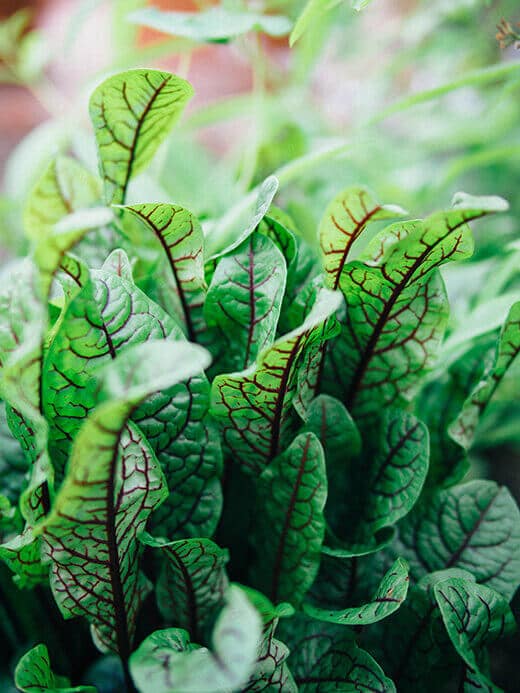I am a fan of the year-round herb garden. While plants like parsley and cilantro may come and go with the seasons, I can always count on a small plot of perennials to thrive when nearly everything else is starting from seed or starting to seed.
Just outside my kitchen door I tend to the standard Mediterranean herbs (basil—the African Blue variety is a non-seeding hybrid that grows all year—rosemary, sage, oregano, thyme, and mint) as well as varieties you’re not likely to find in a market (mitsuba, salad burnet, True French sorrel, wild zaatar oregano, anise hyssop, lime balm, and lemon verbena).
Add bloody dock to that list of bizarre but beautiful herbs that do double duty as an edible green and an ornamental plant.
Bloody dock (Rumex sanguineus) goes by a number of other grisly names like bloody sorrel and bloodwort, or you might have heard it referred to as wood dock, red-veined dock, or red-veined sorrel. The blood-red veins that resemble a spindly winter tree are in shocking contrast to its bright green leaves.


An herbaceous perennial that’s used like a vegetable, bloody dock grows from a tight rosette of lanceolate leaves (much longer than it is wide).
If left to seed, the plant grows tall and leggy with 2- to 3-foot stems of smaller leaves and tiny flowers, which eventually spread their seeds everywhere (some people even consider bloody dock to be a bit weedy).
But if you continually harvest the leaves and never let it flower, the clump stays bushy and compact with tender growth and softer veins.



Bloody dock is hardy down to zone 4 (if protected from snow) but since it’s native to the Mediterranean and Northern Africa, it prefers mild climates and plenty of sun.
Strangely for a warm-weather plant, it does not like to be in a drought. I’ve seen its leaves wilt to the ground in the peak of summer, looking like it’s beyond salvation, only to spring up all lively again after a nice, deep watering.
It needs perpetually damp soil and does especially well in boggy areas. It’s very happy in gardens with heavy clay soil—I simply use its leaves as a barometer to tell me when the earth needs water.
Like many other sour dock and wood sorrel species, including Rumex scutatus (known commonly as True French sorrel) and Oxalis triangularis (known as purple shamrock), bloody dock has a hint of sour from its oxalic acid content.
It’s sort of like a tangy spinach, and I like to use it raw in salads. (You could also add it to soups, like this creamy leek and sorrel soup, but the red pigments do bleed a bit when the leaves are bruised or cut.)
I think of it as a transitional green; it fills in seasonal salads when my lettuce and spinach aren’t yet ready to be picked. It also adds a brilliant pop of color to an all-green salad and I sometimes like to match it with roasted red beets.
And while bloody dock is a delicious leafy green in its own right, for me it’s mostly about the color. I love seeing its stunning color in a landscape—and a landscape I can eat is definitely a perk.

















Absolute gorgeous photos. Something I have not grown before. I might have to give it a try.
Thanks and yes, it’s worth growing just for having something beautiful to look at year-round.
What a gorgeous plant. Although not related, it reminds me of a beetroot leaves because of the red venation of its beautiful foliage. I will definitely be adding it to my repertoire. I am a fan of buckwheat and sorrel family. There is so much you can do with them in the kitchen. Thank you for sharing about this plant. I can’t wait to try it in my cuisine.
Enjoy, it really is a unique herb!
Interesting herb, but it gets confusing when I search by the common names listed. Can you recommend a seed source? I have a raised bed that would be perfect for this plant (providing its non-invasive) and would like to grow it.
Baker Creek carries seeds: http://www.rareseeds.com/dock-bloody-red-sorrel/
Thank you! Great site for seeds, ordered some, hopefully will get it soon. Stocking up for next spring.
Thank you for the source, I have been buying it grown in pots at a local flea market and couldn’t find seeds in my regular catalogues.
Wow, you grew a work of art…simply beautiful…almost to good-looking to eat. Happy Nesting.
I’m surprised I eat anything at all, I always feel homegrown vegetables are too beautiful!
An oddly gruesome name for a vividly beautiful herb. Bloody Dock: Not as Macabre As It Sounds http://t.co/7WyDJaUlx1 #gardenchat
An herb that tastes like a tangy spinach. Bloody Dock: Not as Macabre As It Sounds http://t.co/VlrqiRajSH #gardenchat
Its less grisly names include red-veined dock and wood dock. Bloody Dock: Not as Macabre As It Sounds http://t.co/ts854SFiaB #gardenchat
Count this among the most beautiful herbs in my garden. Bloody Dock: Not as Macabre As It Sounds http://t.co/Q1iqEZsiXa #gardenchat
An ornamental landscaping plant you can eat. Bloody Dock: Not as Macabre As It Sounds http://t.co/95W7K7PWRv #gardenchat
Blogged on Garden Betty: Bloody Dock: Not As Macabre As It Sounds http://t.co/voi6Z8TOO8